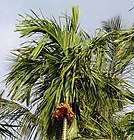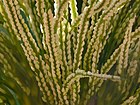Note: This is a project under development. The articles on this wiki are just being initiated and broadly incomplete. You can Help creating new pages.
Areca catechu - Pooga
Pooga consists of dried ripe seed of Areca catechu Linn. (Fam. Palmae), a graceful, slender, stemmed, perennial palm, trunk reaching a height of about 25 m cultivated in the coastal regions of Southern India, Bengal and Assam upto an altitude of 1000 m.[1]
Uses
Scizophrenia, Arecoline, Tapeworms, Anaemia, Fits, Leucoderma, Nasal ulcers, Leprosy, Obesity, Dysentery, Malaria, Constipation, Oedema.
Parts Used
Chemical Composition
It contains Alkaloid (arecoline) tannins and fats etc.[2]
Common names
| Language | Common name |
|---|---|
| Kannada | Adike |
| Hindi | Supari, Chr alia |
| Malayalam | Adakku, Pakku |
| Tamil | Paka chekka, Vakka |
| Telugu | Paka chekka, Vakka |
| Marathi | Supari, Pophal |
| Gujarathi | Supari, Chr alia |
| Punjabi | Supari, Spari |
| Kashmiri | Supari, Spari |
| Sanskrit | Kramuka, Ghonaa |
| English | Areca nut |
Properties
Reference: Dravya - Substance, Rasa - Taste, Guna - Qualities, Veerya - Potency, Vipaka - Post-digesion effect, Karma - Pharmacological activity, Prabhava - Therepeutics.
Dravya
Rasa
Kashaya
Guna
Guru, Ruksha
Veerya
Sheeta
Vipaka
Katu (Pungent)
Karma
Prabhava, Mohakrit, Deepana, Kaphapittajit, Kledanaashana, Malabhedi, Mukhshodhana
Prabhava
Habit
Identification
Leaf
| Kind | Shape | Feature |
|---|---|---|
Flower
| Type | Size | Color and composition | Stamen | More information |
|---|---|---|---|---|
| Flowering season is December to April |
Fruit
| Type | Size | Mass | Appearance | Seeds | More information |
|---|---|---|---|---|---|
| Fruiting season is December to April |
Other features
List of Ayurvedic medicine in which the herb is used
Where to get the saplings
Mode of Propagation
How to plant/cultivate
Plants succeed in moist tropical climates where temperatures never fall below 10°c, the average annual rainfall is 1,500mm or more and the driest month has 25mm or more rain.Prefers a mean annual rainfall in the range 1,500 - 5,000mm, evenly distributed through the year.[4]
Commonly seen growing in areas
[[:Category:Herbs that are commonly seen in the region of |]], [[:Category:Herbs that are commonly seen in the region of |]], [[:Category:Herbs that are commonly seen in the region of |]], [[:Category:Herbs that are commonly seen in the region of |]], [[:Category:Herbs that are commonly seen in the region of |]].
Photo Gallery
References
External Links
- Pages using duplicate arguments in template calls
- Pages that are stubs
- Ayurvedic Herbs known to be helpful to treat Scizophrenia
- Ayurvedic Herbs known to be helpful to treat Arecoline
- Ayurvedic Herbs known to be helpful to treat Tapeworms
- Ayurvedic Herbs known to be helpful to treat Anaemia
- Ayurvedic Herbs known to be helpful to treat Fits
- Ayurvedic Herbs known to be helpful to treat Leucoderma
- Ayurvedic Herbs known to be helpful to treat Nasal ulcers
- Ayurvedic Herbs known to be helpful to treat Leprosy
- Ayurvedic Herbs known to be helpful to treat Obesity
- Ayurvedic Herbs known to be helpful to treat Dysentery
- Ayurvedic Herbs known to be helpful to treat Malaria
- Ayurvedic Herbs known to be helpful to treat Constipation
- Ayurvedic Herbs known to be helpful to treat Oedema
- Herbs with Seed used in medicine
- Herbs with Young leaf used in medicine
- Herbs with common name in Kannada
- Herbs with common name in Hindi
- Herbs with common name in Malayalam
- Herbs with common name in Tamil
- Herbs with common name in Telugu
- Herbs with common name in Marathi
- Herbs with common name in Gujarathi
- Herbs with common name in Punjabi
- Herbs with common name in Kashmiri
- Herbs with common name in Sanskrit
- Herbs with common name in English
- Habit - Evergreen Tree
- Index of Plants which can be propagated by Seed
- Herbs that are commonly seen in the region of
- Ayurvedic Medicine
- Pages without herbs images






